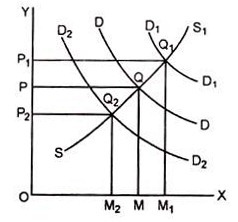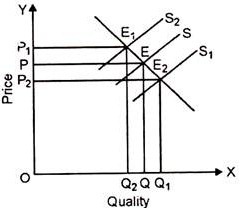The following points highlight the three effects of changes in demand and supply of a product.
The effects are: 1. When Supply is Static but Demand Changes 2. When Demand is Static and Supply Changes 3. When Demand and Supply Both Changes.
Effect of Change # 1. When Supply is Static but Demand Changes:
In the condition when supply is static and there is increase in demand price increases and in decrease in demand price decreases.
This can be explained by the following diagram:
In this diagram the supply curve SS is static and it meets the demand curve DD on point Q and OP equilibrium price is determined. But when demand increases then demands curve goes upward towards right DD1 and meets supply curve SS on the point Q1 and the price increases from OP to OP1.
Again, when demand decreases, then demand curve comes downward at D2D2, which meets supply curve SS to Q2; and price decreases from price OP to OP2 It should be remembered that when supply is static and when there is increase or decrease in demand, then the price increases or decreases and the seller increases or decreases the sales.
Effect of Change # 2. When Demand is Static and Supply Changes:
Changes in supply are due to changes in technical knowledge and the price factor. Figure given above shows the effect of changes in supply. Given the demand, when the supply increases, the supply curve shifts downward.
As a result the price of the product falls and its quantity increases. Taking S and D as the supply and demand curves respectively they intersect at E and establish OP price and OQ quantity. Given the demand when the supply increases, the supply curve S shifts downward as S1 and new equilibrium is established at E2. As a result the price falls from OP to OP1 and the quantity of the product increases from OQ to OQ1.
On the other hand, with the decrease in supply the supply curve S shifts upward as S2. The new equilibrium is established at E1. The price rises from OP to OP2 and the quantity decreases from OQ to OQ2.
Effect of Change # 3. When Demand and Supply Both Changes:
When there is a combined increase in demand and supply, there is a definite increase in the quantity of the product but the rise or fall in price is not certain:
(A) Price rises only when the increase in demand is more than the increase in supply. This is shown in figure (A) where OP and OQ are the equilibrium price and quantity respectively. If there is a combined increase in demand and supply but the increase in demand (D1) is more than the increase in supply (S1), the price rises from OP to OP1 and the quantity also increases from OQ to OQ1.
ADVERTISEMENTS:
(B) On the other hand, if the increase in supply is more than that in demand, the price fails. In diagram (B), the increase in supply from S to S1 is greater than the rise in demand from D to D1. As a result, the new equilibrium point is E1. The new price OP1 is less than the old price OP but the quantity of the product has increased from OQ to OQ1.
(C) When the increase in demand and supply is uniform, there is no change in price. This is shown in diagram (C) where the increase in supply by SS1 is exactly equal to the increase in demand by DD1. The new price E1Q1 equals the old price OP (= EQ) but the quantity has increased from OQ to OQ1.


